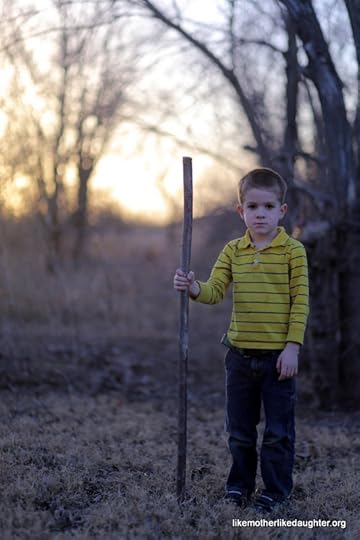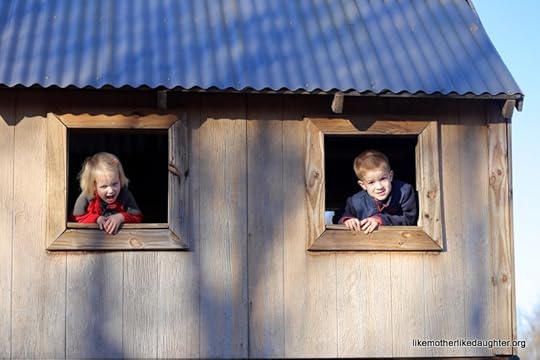Leila Marie Lawler's Blog, page 56
February 13, 2016
{bits & pieces}
The weekly “little of this, little of that” feature here at Like Mother, Like Daughter!

Here we have the spoils of my Super Bowl yarn shop foray. There was a fun sale… and guess what? The owner was holding a raffle and I was one of the winners!! I got a book and four balls of yarn! My friend is bringing my winnings later on today. I’m super excited!
This week’s links:
I had no idea that important records in Britian (and perhaps elsewhere?) are kept on vellum, which is calfskin parchment: MPs plan last ditch bid to save the thousand-year-old tradition of recording Britain’s laws on Vellum.
An excellent meditation on silence in all its forms from Cardinal Sarah: Silence in the Liturgy. This essay is a wonderful companion to our discussion of The Spirit of the Liturgy and quotes from Ratzinger’s book. Glad he mentions stores and offices “where they impose incessant background music on you.” I happen to think that much of the stress people experience today comes from having this grating exposure to “music” without relief. But there’s so much more in this piece!
One of my favorite food bloggers writes about a method for making beans that I have never hear of — have you? Brined, not soaked, beans. Except I think you do soak them — just in brine. Right?
How interesting is this long piece about the book, The Bridge of San Luis Rey, and early Mexican music. Believe me, colonial Mexican music is a revelation. My very tippity-top composer is Tomás Luis de Victoria, and Cristóbal de Morales is wonderful as well. The article has some embedded videos that are well worth listening to as a good introduction to this form of music. The two Magnificats and the orchestral piece are sublime.
The beautiful world of making a Steinway piano.
I feel like building a basement jungle gym for the kids is a good idea (probably not in my basement, which is dirt and stone and big and cold). Maybe just because it’s February and my New England mom instincts are kicking in…
My father was a professor of industrial engineering and I think sometimes it shows here on bits & pieces… anyway, this .gif pleasingly demonstrates the workings of the sewing machine bobbin and the importance of threading the machine correctly. Seriously — if you are thinking that your machine is a problem, I just want you to know that the likelihood that you’ve threaded it wrong is very high. Ask me how I know…
Did you know that condoms can increase the chances of pregnancy? The logic is flawless…
A straight news story from the Chief on a matter of great importance: the meeting between the Pope and the Russian Patriarch.
Speaking of Russia and the Church: A Miracle of Liturgical Art: The Church of the Protection of the Mother of God at Yasenevo. You have to see these images and read the amazing story of the construction and decoration of this shrine.
Finally, our very own Bridget files this report from Rome! Philosophy, poetry, singing, dancing…
It’s the feast of St. Catherine de Ricci.
Don’t forget that we are doing a Book Club here on the blog. You can read along or just read the posts… check in for comments and homework! (This would be a great study for your St. Gregory Pocket!)
Still hoping to see you at this beautiful Mass — the Ordinariate’s Feast of Title and Dedication on the Feast of the Chair of St. Peter, to take place on Feb 22, 7:30 pm at St. Patrick’s upper church, 9 Pomeworth St. Stoneham MA. The Chief and I plan to be there (hope it doesn’t snow). If it doesn’t go too late, we are hoping to stay afterwards for refreshments in the hall. Can you come?

~We’d like to be clear that, when we direct you to a site via one of our links, we’re not necessarily endorsing the whole site, but rather just referring you to the individual post in question (unless we state otherwise).~
Follow us on Twitter.
Like us on Facebook.
Auntie Leila’s Pinterest.
Rosie’s Pinterest.
Sukie’s Pinterest.
Deirdre’s Pinterest.
Habou’s Pinterest.
Bridget’s Pinterest.
Habou’s Blog: Corner Art Studio.
Auntie Leila’s Ravelry.
Auntie Leila’s Instagram.
Rosie’s Instagram.
Sukie’s Instagram.
Bridget’s Instagram. (Bridget is posting from Rome now, so go ahead and request a follow!)
The post {bits & pieces} appeared first on Like Mother Like Daughter.
February 12, 2016
Seeking Universal Prayer ~ The Spirit of the Liturgy: A Lenten Book Club
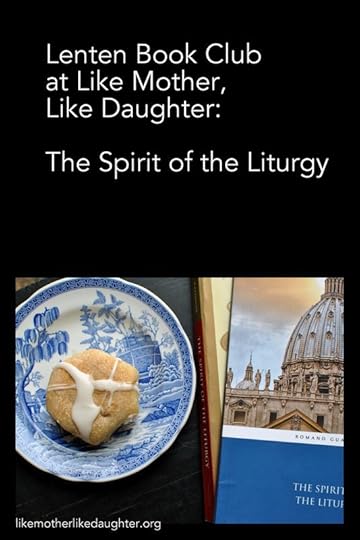
{Lenten Book Club: The Spirit of the Liturgy}
As promised — and I do believe, in keeping with the mission of this blog, which is to talk about what we want to talk about — we will read The Spirit(s) of the Liturgy as a little book club together this Lent. I will post here exactly as I would talk to you about it if we were together. Please add your questions and comments!
First, Romano Guardini’s The Spirit of the Liturgy. It’s free, online. You can also purchase it here, although be warned, this edition does not have the footnotes, which stinks
 .
.Then, Joseph Ratzinger: The Spirit of the Liturgy
 (yes, same name).
(yes, same name).(When you buy something via our Amazon affiliate link, a little cash rolls our way… just a little. Thanks!)
I’ll post on Fridays. I’ll give you your homework, I’ll talk about what we read, we’ll discuss in the comments. You can do this study at any point, but if you want to stay current and join in the convo, that’s how it will go.
*************
Previously: The Introduction: Escaping Preference
Homework: Read Chapter Two for next Friday.
Chapter One, The Spirit of the Liturgy, Romano Guardini
{All emphases in quotes are mine unless noted.}
Psalm 78 (from today’s Office of Readings):
I shall tell of the secrets of the past.
All that we have heard and know –
all that our fathers told us –
we shall not hide it from their descendants,
but will tell to a new generation
the praise of the Lord, and his power,
and the wonders that he worked.
In my introduction to this study I used the word preference. I would say that most of us think of the question of how we worship as very much a matter of preference.
There is another factor going into our inclinations as well, having to do with temperament. Have you ever noticed that some forms of expression really appeal to certain temperaments, and that further, some positions in society are more likely to be filled by people of a certain temperament than others? (Thinking especially of the positions of liturgical director, religious education director, youth minister… all those who affect how we — and our children — worship. )
Much of what any of us today — Protestant, Roman Catholic (not excluding Traditionalists), Jewish (other than Orthodox I think, but I could be wrong), and for all I know even other faiths as well — experience when we worship has to much to do with the temperament of some people being inflicted on the rest.
And that is because we live in a time of the ascendency and even triumph of preference — when what matters is not to do what is right, but to do the will of our own selves or (what we forget in our pride) whoever can impose it — that is, that those with power, even if it’s just the power of their personality, not to put too fine a point on it, get their way.
This chapter is about how the Liturgy* is and must be about something other than will, emotion, or preference; and, when allowed to be what it is, corrects the (very necessary) differences in temperament and emphasis that we will always find in any human undertaking. It corrects and rises above because it is more than human — it is Divine. As a gift, it was not thrown down, whole and entire, from heaven, but arose by the workings of the Holy Spirit according to its nature as worship, as Guardini says at the beginning of the book, precisely from the Church (and that will be further elaborated in Ratzinger’s Spirit of the Liturgy, so hold on).
*In these writings, “the Liturgy” means “the Mass” and also “the Divine Office,” also called “the Liturgy of the Hours.” It also refers to the Liturgical Year. “The Sacred Liturgy” is the Mass. When Guardini is speaking of prayer here, he is not speaking of devotions or private prayer unless he says so.
There is a very simple reason why liturgy must be universal — not an expression of one temperament or style or preference, but appealing to all and able to speak to every person. If it’s worship of God, then no one can be left out, since to worship is to be human, not a certain kind of human.
Universality is the topic of this chapter. Guardini starts with what I imagine might be for many an unsettling statement of the goal of worship:
The primary and exclusive aim of the liturgy is not the expression of the individual’s reverence and worship for God. It is not even concerned with the awakening, formation, and sanctification of the individual soul as such.
Got your attention?
Nor does the onus of liturgical action and prayer rest with the individual. It does not even rest with the collective groups, composed of numerous individuals, who periodically achieve a limited and intermittent unity in their capacity as the congregation of a church. The liturgical entity consists rather of the united body of the faithful as such — the Church — a body which infinitely outnumbers the mere congregation.
The liturgy is the Church’s public and lawful act of worship, and it is performed and conducted by the officials whom the Church herself has designated for the post — her priests. In the liturgy God is to be honored by the body of the faithful, and the latter is in its turn to derive sanctification from this act of worship. It is important that this objective nature of the liturgy should be fully understood.
Here the Catholic conception of worship in common sharply differs from the Protestant, which is predominatingly individualistic. The fact that the individual Catholic, by his absorption into the higher unity, finds liberty and discipline, originates in the twofold nature of man, who is both social and solitary.
He briefly touches on “devotion” (personal prayer) and says this again about liturgy, that it is “the entirely objective and impersonal method of prayer practiced by the Church as a whole.”
And it’s this — the idea of “objective and impersonal prayer” that we are going to examine in these works. Despite the difficulty (and believe me, this is hard, because what I most want to do is read every single line of this work out loud with you while pouring all my thoughts out and hearing yours as well), we just have to get to the bottom of why this man* would say this — this seemingly alien and even grating declaration that shakes the foundations of what most of us find our conception of worship is, which is to do what feels very personal and which will excite certain feelings.
*Who is he? The most important fact about Romano Guardini that you need to know is that he was the mentor of Joseph Ratzinger, who became Pope Benedict XVI of course, and one of the most influential, you might say, of the liturgical reformers who resisted the “liberal” tendencies of the Vatican II era — yet he also resisted the rigidity of neo-Scholasticism. Keep in mind as we read that he wrote this in 1918. His work consists in taking on the theological and philosophical danger of Modernism.
In fact, liturgy threatens, in this time where “will” reigns, to become the meeting of a kind of club, to which only those of the same “style” can belong. That the styles are broadly disseminated and seem widely popular (and even have names) has more to do with the means of communication we enjoy than with their resonance with what is objective or fitting. And we never ask by what authority we choose our own way of doing things.
Continuing to read, we are quickly brought to another stark assertion, so contrary to our prevailing notions:
The first and most important lesson which the liturgy has to teach is that the prayer of a corporate body must be sustained by thought. The prayers of the liturgy are entirely governed by and interwoven with dogma. Those who are unfamiliar with liturgical prayer often regard them as theological formula, artistic and didactic, until on closer acquaintance they suddenly perceive and admit that the clear-cut, lucidly constructed phrases are full of interior enlightenment…
… This is not, of course, an attempt to deny that the heart and the emotions play an important part in the life of prayer. Prayer is, without a doubt, “a raising of the heart to God.” But the heart must be guided, supported, and purified by the mind.
I don’t have access to the original German and I don’t read German anyway, but I am going to be bold and say that these words, “thought” and “mind,” might also be translated as “reason.” The ancients held that man by nature is a rational animal, and St. Thomas Aquinas taught that “the essence of happiness consists in an act of the intellect” [Summa Theological I, II, 3, 4] — not the will. Aquinas expressly rejects the notion that our ultimate happiness (beatitude) is the result of an act of the will, that in fact, to think so would be to fail to grasp the essence of human nature.
Participation in the ultimate act of man in which he is promised happiness, the Sacred Liturgy, must be primarily a matter of reason, not of emotion (although of course emotion, as Guardini says, is there).*
*For a wonderful companion read (I know, I know, sorry!) that elucidates this idea I’ve compacted (violently) here, I recommend Josef Pieper’s Happiness and Contemplation . Pieper was also a student of Guardini.
. Pieper was also a student of Guardini.
What is the result of not worshiping according to thought, dogma, truth, and respect for “interior enlightenment”? Really read this part of the chapter carefully, and consider whether you have experienced what he points to — emotion not “purified by the mind”:
If the content of these devotional forms is of a predominatingly emotional character, it will bear the stamp of its fortuitous [random] origin… Such a prayer therefore will always be unsuitable if it does not [happen to] harmonize, to a certain degree at least, with the disposition of the person who is to offer it. Unless this condition is complied with, either it is useless or it may even mar the sentiment experienced.
The person organizing the prayer or organizing the service, if he departs from the objective character it ought to have, might strike upon a way that resonates with some. And if they are of corresponding temperament, they may make their satisfaction known — and it’s hard, very hard, to argue with someone’s good experience.
But those who are unmoved or who find even that what emotion they had was quenched, not nourished, by the expression, may simply walk away or may never be moved to join in the first place. That is, we might receive feedback about how a particular form of prayer pleased some; we will not have much, if any, of those who weren’t touched.
If, however, religious thought is to do justice to its mission [which, remember, is worship of God, not pleasing some people], it must introduce into prayer truth in all its fullness.
Various individual truths of Revelation hold a special attraction for the temperaments and conditions to which they correspond. It is easy to see that certain people have a pronounced predilection for certain mysteries of faith. This is shown in the case of converts, for instance, by the religious ideas which first arrested their attention at their entry into the Church, or which decided them on the step they were taking, and in other cases by the truths which at the approach of doubt form the mainstay and buttress of the whole house of faith. In the same way doubt does not charge at random, but attacks for the most part those mysteries of faith which appeal least to the temperament of the people concerned.
So, key learning here:
Approach blog posts, essays, and articles that trumpet The ONE Thing You Need to Know About Lent or Five Things To Do This Advent or Ten Important Things about God, with caution. It’s not that they can’t be helpful — very often they are. But they will invariably leave something out, something important. Often the authors are unaware that they are leaving anything out, which is dangerous.
For that matter, a bit above Guardini had said, “The same thing occurs when a form of prayer intended for a particular purpose is considered to be adapted to the most varied occasions.”
I’ve been to Lenten Masses where the same psalm was intoned week after week. There are some who are so in love with one virtue (gratitude, for instance) that they consider it the universal key to every possible human experience.
But this is not what the liturgy teaches us. Any Psalm is true. It is the Word of God. A virtue is good. But the liturgy takes us through every Scripture — not only the ones that appeal to us. It challenges every kind of person to grow in the virtue he needs at that time, not only the one I might happen to be attracted to now, or that He wants for me. Even those who love structure, tradition, and discipline will find a challenge in the liturgy at the propitious moment, meant for the quiet recesses of their hearts, if we let it speak its language of universality.
Now, again, keeping in mind that this was written a century ago:
If a prayer therefore stresses any one mystery of faith in an exclusive or an excessive manner, in the end it will adequately satisfy none but those who are of a corresponding temperament, and even the latter will eventually become conscious of their need of truth in its entirety. For instance, if a prayer deals exclusively with God’s mercy, it will not ultimately satisfy even a delicate and tender piety, because this truth calls for its complement — the fact of God’s justice and majesty. In any form of prayer, therefore, which is intended for the ultimate use of a corporate body, the whole fullness of religious truth must be included.
Here, too, the liturgy is our teacher. It condenses into prayer the entire body of religious truth. Indeed, it is nothing else but truth expressed in terms of prayer…
… It is only such an overwhelming abundance of truth which can never pall, but continue to be, day after day, all things to all men, ever fresh and inexhaustible.
The rest of this section on truth bears careful reading, and I will leave that to you.
But I want to be sure to touch on Guardini’s thoughts on emotion in the liturgy.
He says, “Liturgical emotion is controlled and subdued.” In our time, a time marked by abandonment of reason in favor of the will (and we will discuss why later), our goal has indeed become to seek an experience of emotion that is uncontrolled and anything but subdued.
But — seeking fulfillment through emotion leads to manufactured emotion.
So we are really going to learn something here about “a sense of restraint in the liturgical form.”
The restraint characteristic of the liturgy is at times very pronounced–so much so as to make this form of prayer appear at first as a frigid intellectual production, until we gradually grow familiar with it and realize what vitality pulsates in the clear, measured forms.
And how necessary this discipline is! At certain moments and on certain occasions it is permissible for emotion to have a vent. But a prayer which is intended for the everyday use of a large body of people must be restrained. If, therefore, it has uncontrolled and unbalanced emotion for a foundation, it is doubly dangerous. It will operate in one of two ways. Either the people who use it will take it seriously, and probably will then feel obliged to force themselves into acquiescence with an emotion that they have never, generally speaking, experienced, or which, at any rate, they are not experiencing at that particular moment, thus perverting and degrading their religious feeling. Or else indifference, if they are of a phlegmatic temperament, will come to their aid; they then take the phrases at less than their face value, and consequently the word is depreciated.
Guardini speaks of this beautiful expression prayed in the Divine Office: “Sober inebriation.”
In these two words we see the perfect uniting of the two elements of our nature, the mind and the heart. We understand that when we worship aright, we won’t lose ourselves in some atavistic thrumming dissolution of our very selves into the abyss. Nor will we frigidly remain at the foot of the mountain we can never hope to ascend. God has something else in mind for us.
And it’s not only in the emotions that the liturgy is restrained. Morality too is expressed with reservation: “The liturgy is very cautious,” he says. Again Guardini identifies the extremes. Think on the one hand of the “love and do what you will” crowd who want never to mention a Commandment yet are continually exhorting the faithful to do certain good works (or participate in certain programs), and on the other the ones who want every sermon and prayer to be about specific moral issues.
In moments of exaltation and in the hour of decision such a manner of speech [specifically mentioning moral actions] may be justified, and even necessary. But when it is a question of the daily spiritual life of a corporate body, such formulas, when frequently repeated, offer those who are using them an unfortunate selection from which to make their choice.
Perhaps they take the formulas literally and endeavor to kindle the moral sentiments expressed in them, discovering later that it is often difficult, and sometimes impossible, to do so truthfully and effectually. They are consequently in danger of developing artificial sentiments, of forcing intentions that still remain beyond their compass, and of daily performing moral actions, which of their very nature cannot be frequently accomplished. Or else they take the words merely as a passing recommendation of a line of conduct which it would be well to adopt, and in this way depreciate the intrinsic moral value of the formula, although it may be used frequently, and in all good faith.
In this connection are applicable the words of Christ, “Let your speech be yea, yea,–nay, nay.”
This chapter is full of ideas. Other than the last chapter, I think this is as long as my posts will be for this book. So sorry if you’ve made it this far — you are the best! I think we could spend all year, actually, just on this one chapter! Ponder how it ends:
Prayer must be simple, wholesome, and powerful. It must be closely related to actuality and not afraid to call things by their names. In prayer we must find our entire life over again. [So you can see why it might have to take a year to complete the cycle of prayer… the Liturgical Year. And then a lifetime of praying those years.] On the other hand, it must be rich in ideas and powerful images, and speak a developed but restrained language; its construction must be clear and obvious to the simple man, stimulating and refreshing to the man of culture. It must be intimately blended with an erudition which is in nowise obtrusive, but which is rooted in breadth of spiritual outlook and in inward restraint of thought, volition, and emotion.
And lest we get a panic attack thinking of how we will bring all this about, he ends by assuring us:
And that is precisely the way in which the prayer of the liturgy has been formed.
The post Seeking Universal Prayer ~ The Spirit of the Liturgy: A Lenten Book Club appeared first on Like Mother Like Daughter.
February 11, 2016
{pretty, happy, funny, real}
What is this {pretty, happy, funny, real} you speak of?
~ {pretty, happy, funny, real} ~
Capturing the context of contentment in everyday life ~
Every Thursday, here at Like Mother, Like Daughter!
I was glad to read in Rosie’s quilt post that she gets the urge to start bigger projects when her baby is about Nora’s age. I’m not there yet for sure!
But I’m starting to feel like maybe I’m settling into my new life here.
Two babies, a new house, and a husband in residency had me drowning for a bit there. Now I’m reveling in every tiny bit of efficiency we’ve worked into the house.
My ridiculous kitchen is much more usable now. The Quack and his brother-in-law hung up some pot racks for me.
They are the best! I’m sure you’ve all rummaged around in a cupboard for a pan while holding a baby and fending off an inquisitive toddler with–what? a shoulder? It’s madness! Now I just reach up one-handed and lift one down while rocking the baby in the other hand, while the toddler watches in vain, unable to destroy anything!
Plus, they’re pretty, especially when the light catches them just so.
They do seem like they’re a bit high, but I can reach all of them fine, and this way the pans on the bottom rack are still well out of the reach of my little helper.
We also put these racks in the corner under the cabinets. All the things that I use fairly frequently but are a pain to have cluttering up my drawers go on here. I keep cooking utensils I reach for all the time in that green floral canister. Before we put up these hooks, the canister was overfilled and getting out a wooden spoon was a battle even with no children involved.
Really, I think we should all have everything hanging off our walls. It’s so much more efficient than cupboards and drawers! I just love efficiency.
(Desmond is not efficient. But he’s cute!)
The other day we were on our way to meet people and were going to arrive a bit early. Both babies were asleep, and there was a T.J. Maxx nearby. I hopped out and spent ten blissful minutes shopping by myself while the Quack drove in circles.
I got a rubber spatula (can you ever have too many? No you cannot, and now it’ll fit in my canister too), a storage container, and this charming soap dispenser. That’s dish soap in there–no need to tip a bottle, and it’s so delightful!
[image error] Loading InLinkz ...
The post {pretty, happy, funny, real} appeared first on Like Mother Like Daughter.
February 10, 2016
Escaping Preference: An Introduction to Our Lenten Book Club
{Lenten Book Club: The Spirit of the Liturgy}
As promised — and I do believe, in keeping with the mission of this blog, which is to talk about what we want to talk about — we will read The Spirit(s) of the Liturgy as a little book club together this Lent.
First, Romano Guardini’s The Spirit of the Liturgy. It’s free, online. You can also purchase it here
 .
.Then, Joseph Ratzinger: The Spirit of the Liturgy
 (yes, same name).
(yes, same name).(When you buy something via our Amazon affiliate link, a little cash rolls our way… just a little. Thanks!)
I’ll post on Fridays. I’ll give you your homework, I’ll talk about what we read, we’ll discuss in the comments. You can do this study at any point, but if you want to stay current and join in the convo, that’s how it will go.
**********
For Friday, read Chapter One, “The Prayer of the Liturgy,” of the Guardini book or flunk out don’t worry because it will all be here in that great organized way we have of offering series. Trying to do better this time. And Chapter Two will be next Friday, so you can look ahead to that (and have a bit more time).
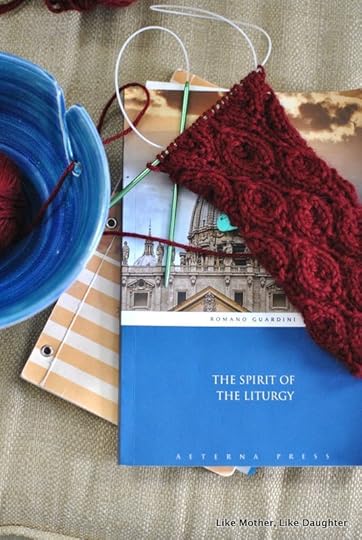
Here you can see why I did break down and spend $7 on this book:
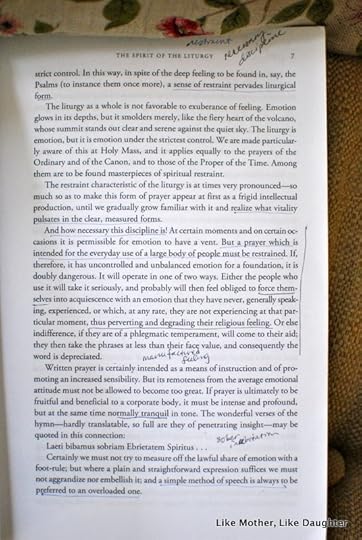
One more read-through and I think each and every sentence will be underlined.
If it weren’t for you great and wonderful readers, I would never have the sheer cheek to attempt something like this study.
The Spirit of the Liturgy is a rather philosophical attempt to make the case for universal, objective, joyful, and serene worship. It’s an inquiry into what the essence of such worship is and what it ought to be. Guardini offers a fresh way of looking at what it means to worship while being grounded in the most fundamental philosophical and theological ideas.
There are points made in this book that I strongly suspect will be new to you. They were new to me, although instantly recognizable. That’s why I so strongly feel moved to share my reading with you. It’s an exciting book, against all expectations! (And then, just wait for the other one. Swoons of ecstasy!)


Probably most of our readers here at Like Mother, Like Daughter are married women who are devoting themselves to building their home. We have a fair number of readers who are unmarried women, some who have already raised their children and like to stop by for a cup of tea and a read, and even some guys — great, thoughtful men who appreciate what we hope is a reasoned and sometimes fun apologia for home life, in which they too are heavily invested. In fact, you could say, it’s what they work for, when all is said and done.
So we have a lot of homemaking things to talk about here, and we love it. I can talk the price of potatoes all day. Want to see what I’m knitting? Glad to show you. Let’s paint a room together!
But I have never for one minute bought the lie that a woman whose path in life can be described as “homemaker” — or even, to use my very favorite un-PC term, “housewife” which is what I call myself on forms — gives up using her mind. “So, if you stay home, will you… stop thinking?” I have been asked this in my day.
There are many silly, thought-free people in the world. Some of them, perhaps, are stay-at-home moms. I am willing to concede that possibility. Some are not, let’s be honest, stay-at-home anythings. They are all too “out there” if you ask me.
But intelligent people can be found everywhere, if you look hard enough, and many of them also love to knit, quilt, garden, and keep bees. So we won’t make any assumptions.
Except for this one: we will assume that readers of Like Mother, Like Daughter are highly intelligent and, furthermore, are up for anything. Including a rather tricky Lenten journey through the wilds of philosophy, theology, and what have you, in order to find some answers to a troubling question.
It’s tricky because your guide, yours truly, lacks all the necessary credentials to be leading you. However, she is left to do it by default. Thus, it must be.
Yes, the reading is daunting. It’s way more daunting than even the most daunting Facebook post. But it will be good for you and I will help you. When I can’t, I’ll find someone who will.
We have to (I hope I can say “we”), because of the troubling nature of the question, as I mentioned. This question is at the very heart of the darkness that I believe has overtaken us as a civilization.
And I don’t mean in the past 10 or even 50 years. I mean in the past… 200 and even 500 (some might say 700) years. It’s crept up on us and now we are living out its inner logic. (We talked a little about it just a little in this post about The Abolition of Man, a book in which C. S. Lewis deals with the question from the different angle of the education of the young, perhaps the most important, after the subject of worship.)
This question has to do with whether something exists outside of ourselves, or whether reality is merely what we shape it to be by our preferences — or by the preferences of those we find we have no power to resist.
Reality. What is it?
If reality exists apart from ourselves, then worship — from all evidence a universal human impulse (as we will see when we go on to Joseph Ratzinger’s Spirit of the Liturgy) — has a different character from what it has if it’s only an urge, arising from the breast of man (as perhaps the result of collisions of chemicals?) with no goal external to him.
Worship is either preference — a nice add-on to a comfortable life, or the desperate and meaningless expression of a suffering life — or it is our one duty and happiness — the possession of what we are made for and most desire.
Since you are, we hope, living your Lent, simply and peacefully, perhaps you will be able to find time for some deep reading and grappling of big thoughts. I really appreciate you coming along with me!

The post Escaping Preference: An Introduction to Our Lenten Book Club appeared first on Like Mother Like Daughter.
February 9, 2016
A triangle quilt for a big boy bed
This is an old project that I’ve been meaning to show you for some time now. I started it when Molly was about the same age that Nora is now, which is to say, about a year and a half ago. We had just moved Pippo into his big boy bed, and he needed a quilt. So of course I had to make him one!
I basically have two modes when it comes to working on projects: either I get stuck in an endless crippling loop of planning, trying to find the exact right pattern/colors/fabrics/techniques, or else I decide not to plan at all, and just jump right in. I’m sure there is some string of letters that expresses this in terms of personality type, but one of those letters would also represent the fact that I inevitably get distracted about 25 questions in to those personality tests, and can never make it to the end. I think I might have made it through, once, but then I promptly forgot my letters, and now just feel left out with all the INTF talk. Is there a letter for that? Probably.
Anyway, this quilt falls into the latter, jump-right-in category. While I was working on it, I actually named my process: it’s called Path of Least Resistance Quilting. It got that name when I accidentally sewed two sets of triangles together the wrong way (no matter how many times I tell myself “right sides together,” something always falls through the crack), and rather than quickly rip out the seams and do it properly, I told them: “you’re dead to me,” and tossed them aside.
(I did actually save them, just in case I didn’t have enough at the end. Because, you remember, I didn’t plan at all, and had no idea if I would be able to make a rectangle-shaped quilt, let alone a coherent pattern. But, miracle of miracles, I had exactly enough.)
To give you a quick rundown of how Path of Least Resistance Quilting (PLRQ) works: First of all, I only used supplies I had on hand. From start to finish, all I bought were a few extra skeins of the embroidery thread for quilting. Everything else, including the batting, I already had in my stash. Yes, I have a problem.
I pulled out all the fabrics I was considering, and three-year-old Pippo immediately divided them into two piles: the ones he liked, and the ones he didn’t. I tried to sneak one back into the good stack at one point, thinking he wouldn’t notice, but he definitely called me out on it. Luckily he has good taste, or I would’ve been in trouble!
(Edited to add: since I’ve gotten a bunch of queries about the alphabet posters in the comments, I thought I’d add the info about them here. The alphabet prints are actually sheets of pretty wrapping paper that Habou sent us. I popped them into cheap poster frames that I’d spray-painted red (so, altogether, an inexpensive way to cover a lot of wall space!), and the kids love looking at them. They’re really cute! Habou found them at a local papergoods store, I think, but I tracked down one of them on Amazon, here: Cavallini Decorative Paper- Vintage Illustrated ABC I didn’t see the other one with a quick search, but I know it’s made by the same company, which also has a lot more cute designs that look like they belong in a vintage schoolroom.)
I didn’t see the other one with a quick search, but I know it’s made by the same company, which also has a lot more cute designs that look like they belong in a vintage schoolroom.)
I was pretty confident in the overall look I was going for (I have a whole bunch of simple but beautiful quilts pinned), which I had internalized as “bright, modern, colorful, triangle quilt,” so I just cut everything into six-inch squares (because that’s the width of my ruler, and thus the easiest size to cut out quickly) and made a big batch of half-square triangles. When I ran out of white fabric, I declared myself done, and spent a while arranging and rearranging them on the floor (always with the assistance of my trusty helpers, as you can see above) until I settled on this sort of flying geese-ish pattern.
I can’t believe it worked, either. I honestly had at most a square or two to spare. But I’m telling you, Path of Least Resistance Quilting works. Sometimes.
As I mentioned, I had the batting on hand and pieced together the backing from my stash, hand quilted with pearl (perle?) cotton embroidery thread, fought the good continuous bias binding fight and came out on the other side with a cute triangle quilt.
Pippo and I are both very pleased with it, and I think it only took me about six months from start to finish, which isn’t too bad, considering the derailing effects of a first trimester on one’s crafting efficiency.
Molly is still quite happily in her crib — which is good, because I’ve been on a stashbusting and project-finishing mission lately and need to get through a few more things before I can start on a big girl quilt for her. I think that this flurry of creative energy must be part of my postpartum routine — once my baby hits a certain age, I start to believe that I really can keep our daily family life going on a basic level, and realize that I also need to make some time to make something beautiful. Do you experience this, too?
The post A triangle quilt for a big boy bed appeared first on Like Mother Like Daughter.
February 6, 2016
{bits & pieces}
The weekly “little of this, little of that” feature here at Like Mother, Like Daughter!
Be sure to use the discount code LO30 for 30% off The Little Oratory this week at Sophia Institute Press — only for Like Mother, Like Daughter readers. They offer $5 flat shipping for all orders in the US, by the way!

Just giving local folks a heads up about this beautiful Mass — the Ordinariate’s Feast of Title and Dedication on the Feast of the Chair of St. Peter, to take place on Feb 22, 7:30 pm at St. Patrick’s upper church, 9 Pomeworth St. Stoneham MA. My mom and The Chief plan to be there! (And aren’t their handbills beautiful?)
This week’s links!
Lettering and handwriting:
I loved this video of the master penman Jake Weidmann. I’m inspired by how he has always striven to make everything he writes – even class notes when he was a kid – beautiful. The dedication pays off, as you will see!
I think it’s common sense to most of us, but it’s worth learning about it some more depth: why handwriting notes is more effective than typing. I am obsessing about how much I’m loving my newly adopted habit of using a physical daily planner this year – I hope to blog about it soon.
In other art news:
Perhaps you and/or your kids would enjoy this Bodleian Coloring book which you can print out?
An article on Norman Rockwell’s illustrations of Huckleberry Finn.
A collection of beautiful photos of Hong Kong from the 1950s.
From Pondered In My Heart, a lovely, hand-drawn Lenten Calendar you can print out and your little ones can color in – a helpful visual aid to the Lenten journey.
Some Politics lessons:
How does the presidential election process actually work? A poster and accompanying info.
And another, short article: Who Elects the President?
On Relationships:
Complementarity: Lessons from Little House in the Big Woods. Have you ever thought about how formative this classic American story is, as far as understanding the important differences between mothers and fathers (or Mas and Pas)? We are currently obsessing over this book, as Finnabee received it on audio from her uncle for Christmas and can.not. get. enough. (Yesterday evening she spent a fair amount of time chasing “panthers” using the long wand attachment of my vacuum.)
The End of Small Talk. This man reflects on how to change the dating scene – and the friend-seeking-scene in general – by eliminating dull small talk. What do you think? On the one hand, I find it appealing because yes, in general I’d rather jump right into a fascinating and personal conversation with someone. On the other hand, it seems like an attempt to short-cut through the ground-laying work of relationships. Would you find this guy to be pleasantly authentic, or… jerky?
How Our Housing Choices Make Adult Friendship More Difficult. I’m always interested in a thoughtful critique of modern residential planning and how it affects culture. I found this piece very thought-provoking. I will say, however, that I take issue with a few premises here; the resistance to unsupervised children’s play being one of them.
We, of course, advocate the Pockets as a remedy for difficulty in making friends and sharing life with them! In an ideal world, the Pocket would be as local as possible, so that this “walkable” form of friendship would be attainable. But it is interesting to note how our infrastructure can be working against us.
In the liturgical year:
Today is the Memorial of St. Paul Miki and Companions!
From the archives:
Get your Lenten ducks in a row! And by ducks we mean books. (Yes, by archives we mean yesterday.)
A really nice salad with roasted squash and whole grains from Rosie.
A lesson on brainstorming your menu planning.
~We’d like to be clear that, when we direct you to a site via one of our links, we’re not necessarily endorsing the whole site, but rather just referring you to the individual post in question (unless we state otherwise).~
Follow us on Twitter.
Like us on Facebook.
Auntie Leila’s Pinterest.
Rosie’s Pinterest.
Sukie’s Pinterest.
Deirdre’s Pinterest.
Habou’s Pinterest.
Bridget’s Pinterest.
Habou’s Blog: Corner Art Studio.
Auntie Leila’s Ravelry.
Auntie Leila’s Instagram.
Rosie’s Instagram.
Sukie’s Instagram.
Bridget’s Instagram.
The post {bits & pieces} appeared first on Like Mother Like Daughter.
February 5, 2016
Wondering what to read this Lent?
After a warm-ish week here in New England, it’s finally snowing. That’s a relief. The mud gets depressing!


I like to be in denial about Lent until the last second. I’m really a wimp about giving up my ice cream.
Clinging to good old Ordinary Time here.
However, it is coming, so I thought I’d pop in and give some suggestions so that you have time to order the books if you don’t have them. How amazingly on top of it am I??
Especially, I wanted to give you a heads up for ordering or otherwise obtaining two books that I want to do a blog book club about — and they’d make an excellent choice for your St. Gregory Pocket discussions as well.
I’m a little nervous, because I’m not in any way qualified to discuss them, except that I am under the impression that I understand them and furthermore, that they have real implications for what we are trying to do in here. Worship, life, teaching our children…
So here are those books:
The Spirit of the Liturgy, Romano Guardini
 (this is available for free online — personally, my copy is completely marked up, so it was worth it for me to buy a hard copy, even though the edition is not very well edited)
(this is available for free online — personally, my copy is completely marked up, so it was worth it for me to buy a hard copy, even though the edition is not very well edited)The Spirit of the Liturgy, Joseph Ratzinger
 (completely worth owning a copy of — Ratzinger of course went on to become Pope Benedict XVI)
(completely worth owning a copy of — Ratzinger of course went on to become Pope Benedict XVI)The second one is a “response” and builds on the first. So really, they need to be read together. I want to read them with you. Can I do it?? Do you want to??
We shall see.
For your own reading, may I offer a few thoughts?
If you are looking for fiction that has you digging deep, may I recommend:
Gilead: A Novel
 by Marilynne Robinson. A beautiful, quiet book of letters of a father to his young son as he faces death. Not many authors can talk point-blank about theological matters and still be writing good fiction. (I’d say George MacDonald was one: try The Curate’s Awakening
by Marilynne Robinson. A beautiful, quiet book of letters of a father to his young son as he faces death. Not many authors can talk point-blank about theological matters and still be writing good fiction. (I’d say George MacDonald was one: try The Curate’s Awakening  if you’ve already read the The Curdie books
if you’ve already read the The Curdie books , which are written for children — did you know that he wrote novels as well? Some are not great quality, but some are very good if you are looking for a romance that has more to it than just fluff.) Robinson’s writing is magnificent. She has complete control of her craft.
, which are written for children — did you know that he wrote novels as well? Some are not great quality, but some are very good if you are looking for a romance that has more to it than just fluff.) Robinson’s writing is magnificent. She has complete control of her craft.I wrote about Vipers’ Tangle
 and The Diary of a Country Priest: A Novel
and The Diary of a Country Priest: A Novel in this post (I also wrote about Gilead there). And if you haven’t read C. S. Lewis’Till We Have Faces, now’s the time. (Gosh, it’s all in that post.) (Go look in the Library Project for other novels if you are needing them.)
in this post (I also wrote about Gilead there). And if you haven’t read C. S. Lewis’Till We Have Faces, now’s the time. (Gosh, it’s all in that post.) (Go look in the Library Project for other novels if you are needing them.)Keep in mind what I said here the other day: Lent gives us the opportunity to begin again (or, just begin!) praying — and praying with the family.
To that end, the book that David Clayton and I wrote (and Deirdre contributed illustrations to, besides David’s), The Little Oratory: A Beginner’s Guide to Praying in the Home , is the manual you need. In the section on the Liturgical Year, we tell you exactly how to use Lent to get started on prayer in the home. The book also has icons for easy detaching and framing, so that you can finally make a prayer corner in your own home.
, is the manual you need. In the section on the Liturgical Year, we tell you exactly how to use Lent to get started on prayer in the home. The book also has icons for easy detaching and framing, so that you can finally make a prayer corner in your own home.
If you want to buy from Sophia, the publisher, use the discount code LO30 for 30% off the book. They offer $5 flat shipping for all orders in the US, by the way!
If you don’t usually see yourself reading Papal documents, maybe this Lent is the time to try! I highly recommend On Christian Marriage (Casti Connubii), Pius XI . This encyclical is also available online, but if you read my commentary along with it, you might want a hard copy of the book to underline and easily navigate.
. This encyclical is also available online, but if you read my commentary along with it, you might want a hard copy of the book to underline and easily navigate.
I am this close to offering you an Ebook that will be an edited and collated version of my Casti Connubii posts — that will be very handy for you to be able to share with your St. Greg’s Pocket or other reading group.

The post Wondering what to read this Lent? appeared first on Like Mother Like Daughter.
February 4, 2016
{pretty, happy, funny, real}
What is this {pretty, happy, funny, real} you speak of?
~ {pretty, happy, funny, real} ~
Capturing the context of contentment in everyday life ~
Every Thursday, here at Like Mother, Like Daughter!
First up — the winner of the pocket oratory and a copy of The Little Oratory: Hannah Marie! Congratulations, Hannah Marie, and look for an email from us about how to claim your goodies.
If you are not Hannah Marie, but still have your heart set on one of those sweet pocket oratories, Nanci is offering LMLD readers a special discount — just enter LENTPRAYER when checking out in her shop for 15% off through Ash Wednesday.
We’re still in the process of painting the study — being able to shut the door on the whole mess of a project means that we can do it in fits and spurts, but it also means that it can take a long time. The built-ins are done, though not actually put back together yet. (they’re currently holding the contents of the room’s other two, non-built-in bookshelves while we paint behind those. I told you this room was crowded!) Aren’t they looking Fresh and White?!
We’re currently debating whether to go ahead and paint the walls too. (we have plenty of leftover wall paint from the living room and it could use a freshening up, but we also could not worry about it, and it would still look pretty good. And if we paint the walls, we probably need to do the ceiling too, and ugh, is there anything worse than painting ceilings??)
Let the record show I am using the pronoun “we” loosely here. I’ve been doing my fair share of the debating and the book-moving, but practically none of the painting…
Winter in Oklahoma means 80-degree days and wind chills in the teens, all in the same week. We try to take advantage of the warm afternoons when they come along.
(This is a good shot of Molly’s new haircut. I’ve never cut the front of her hair — she has natural bangs. And after a few weeks of her refusing me putting elastics in her hair, we gave her a fresh little bob to give the front a chance to catch up a bit. Naturally, the following day she came to me with every elastic and barrette she could find, and asked for me to put them all in at once.)
Their big thing these days is to eat their snack up in the treehouse. We divide it up into two bags so they each have something to carry.
[image error] Loading InLinkz ...
The post {pretty, happy, funny, real} appeared first on Like Mother Like Daughter.
February 3, 2016
Wedding Pysanky for Suki

My mind has been turning to my beloved pysanky more and more, recently. I think it’s the start of a new year. I have identified that I really would like to be spending more time doing the arts and crafts that I love, and so I’ve been pondering what changes I can make in my life to try to make that happen. We all know it’s not easy.
In any case, how about a glimpse of some work I finally got around to doing in the summer of 2014? I thought I’d share the finally-gotten-around-to project: Suki’s Wedding Pysanky.
You’ll recall that I made Wedding Pysanky for each of my two eldest siblings, when they got hitched. So it’s probably going to have to be a thing.
I love to do it though. Weddings are great (you know I love weddings) — the inspiration is all there. In Suki’s case, her beautiful invitation:
I did a draft egg. As with the others, this is a goose egg.
I just threw on some text in place of the happy couple’s names and their wedding date. Just needed to see what I was working with in terms of color, pattern, etc…
I liked it, but it definitely needed some tweaking. I returned to her wedding photos for some more input. As you can see from her pictures below, there was SO much color and brightness. Hard to capture all of that with layers of dye!
I definitely wanted to incorporate the wedding quilt and hints of all the lovely fabric that was present on that day:
The final product:
Only in the past few years have I discovered drafting pysanky. It seems so obvious, and of course I’ve always been a big believer in drafting and sketching for other art projects, but for some reason I had a mental block with my eggs. I’m much better off now. You can see that I refined the palatte a bit and tidied up my white layer and fine lines in the real version.
Because one traditionally works from light to dark in pysanky, I had to wax on all the white first, and then fill in the other colors as I went. So the hardest work came at the beginning. The two side by side:
Still searching for a good pink, though. Maybe for a 30th anniversary gift?
The post Wedding Pysanky for Suki appeared first on Like Mother Like Daughter.
February 2, 2016
Crystallized ginger chocolate chip sugar cookies


Good morning! Today is Candlemas! Want to make some crystallized ginger chocolate chip sugar cookies?
If you are in the Boston area, maybe we will see you tonight at the Anglican Use parish, St. Athanasius? 7:30 pm! Get those candles blessed!


Mine are all ready to go. I’ve scrounged some up. I feel like those nasty LED ones have pushed out real ones (our friend Fr. P calls those “contraceptive candles” and that’s rather apt!). My need is mainly for votives, which seem to be the very ones that are least available with any kind of quality. The very best ones I ever found were Shabbat 5-day votives — I picked them up on clearance after Passover one year at the grocery store. But now I can’t even find those.
Okay, enough complaining (note to self, give it up for Lent).

Let’s eat some delicious sugar cookies! Before it’s too late!
My go-to sugar cookie recipe (below) is from The All New Good Housekeeping Cook Book (this version I’m linking to is awesome). These drop cookies quick, easy, buttery — and I’ve taken to adding little fun things to the recipe. Sometimes I add chopped dates, sometimes toffee bits, sometimes coconut flakes. Sometimes I swap out half the regular sugar for brown sugar, or replace some of it with honey. Anyway, they mix up in a jiffy and everyone loves them. More, they are intrigued by them, because the texture isn’t quite what they are expecting…
(this version I’m linking to is awesome). These drop cookies quick, easy, buttery — and I’ve taken to adding little fun things to the recipe. Sometimes I add chopped dates, sometimes toffee bits, sometimes coconut flakes. Sometimes I swap out half the regular sugar for brown sugar, or replace some of it with honey. Anyway, they mix up in a jiffy and everyone loves them. More, they are intrigued by them, because the texture isn’t quite what they are expecting…
This time, I chopped up some crystallized ginger and threw in some mini chocolate chips. This is it, my friends. An inspired combination! The ginger gives it a little pop and a little softness, and the chocolate chips, well, everything needs chocolate chips!


So by the way, if you can swing (space-wise, which I really can’t) having two bowls for your KitchenAid mixer, I highly recommend it. This is a big-family thing. Since I let my dough proof and do its first fermentation right in the bowl, it’s ever so handy to have another one for crystallized ginger mini chocolate chip sugar cookies! Or what have you. If you don’t have lots of baking to do, it’s hard to make this seem like a necessity, but if you do (because of those hordes of children), you’ll see.





Crystallized Ginger Mini Chocolate Chip Sugar Cookies, Like Mother, Like Daughter
(I’ve doubled the original recipe here. The cookies freeze perfectly if for some unknown reason you need to do that.)
1 cup (2 sticks) butter, softened
1 cup sugar
1 cup brown sugar
2 large eggs
2 tsp. vanilla extract
2 2/3 cups all-purpose flour
1 1/2 tsp. baking powder
1/2 tsp. salt
1/2 to 2/3 cup chopped crystallized ginger of high quality
1 cup mini dark chocolate chips of high quality
Preheat oven to 375°. Cream butter and sugars until light and fluffy, 2 minutes. Add the eggs one at a time. Add the vanilla.
Mix in the dry ingredients. Mix in the ginger and the chocolate chips.
Drop the dough onto the ungreased cookie sheet, leaving room for them to spread*. If you like, you can roll the dough in coarse sugar or sprinkle some on top of each little ball, but with the crystallized ginger it’s not really necessary.
Bake until the cookies are just slightly browned and puffed, rotating them halfway through the baking time of 12 minutes or so.
Transfer to a wire rack to cool completely.
Makes around 60 cookies.
_______________
*I like to use this scoop . A few years ago, Bridget said that she loves making cookies but hates the scooping part. Suddenly, after a lifetime of cookie-baking, I realized that she is right! So for her birthday we got her this scoop (among other things, don’t worry, we aren’t complete self-serving monsters). It’s a little stiff on the hands after a while, but it’s well made.
. A few years ago, Bridget said that she loves making cookies but hates the scooping part. Suddenly, after a lifetime of cookie-baking, I realized that she is right! So for her birthday we got her this scoop (among other things, don’t worry, we aren’t complete self-serving monsters). It’s a little stiff on the hands after a while, but it’s well made.
The post Crystallized ginger chocolate chip sugar cookies appeared first on Like Mother Like Daughter.





























